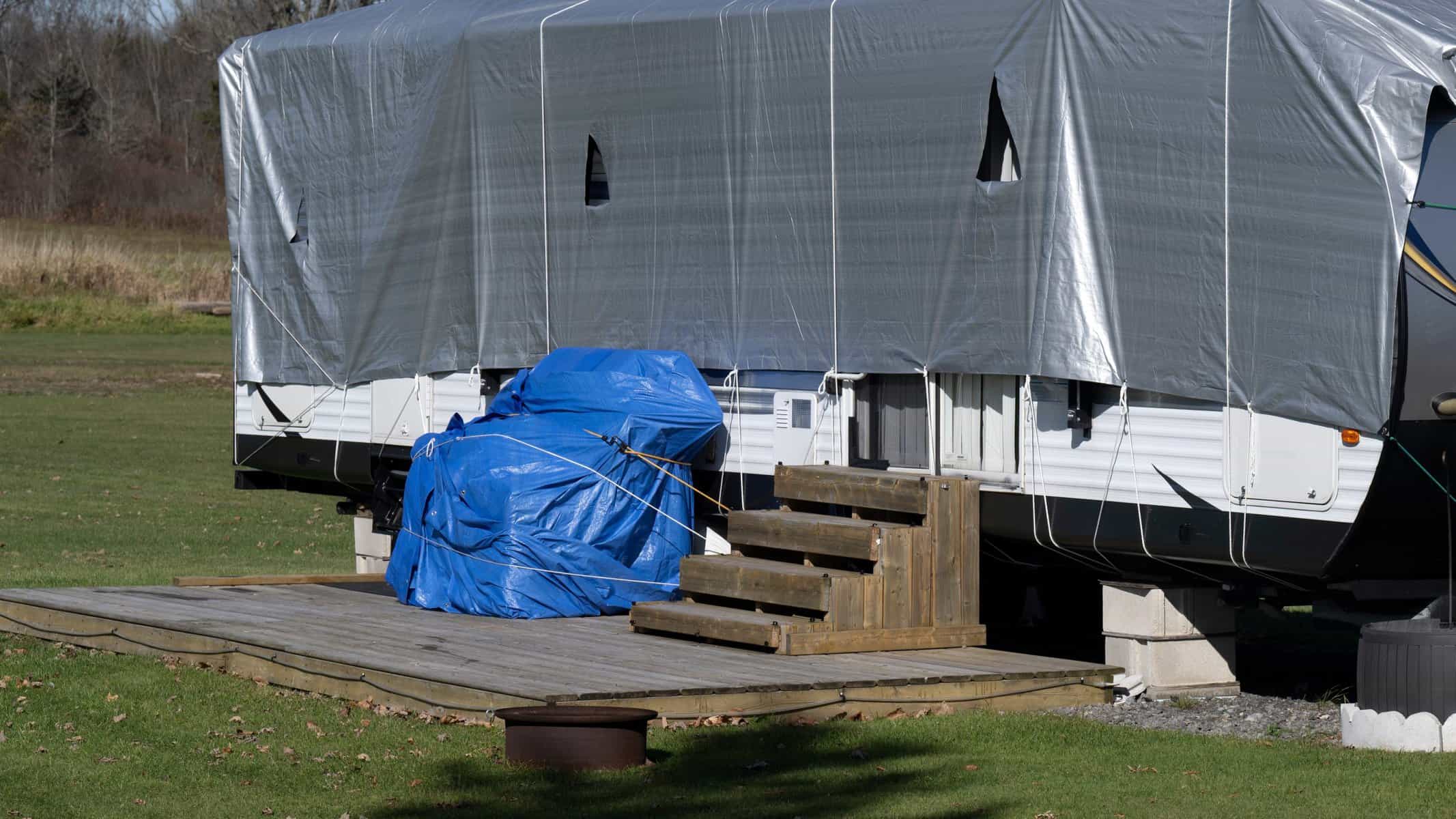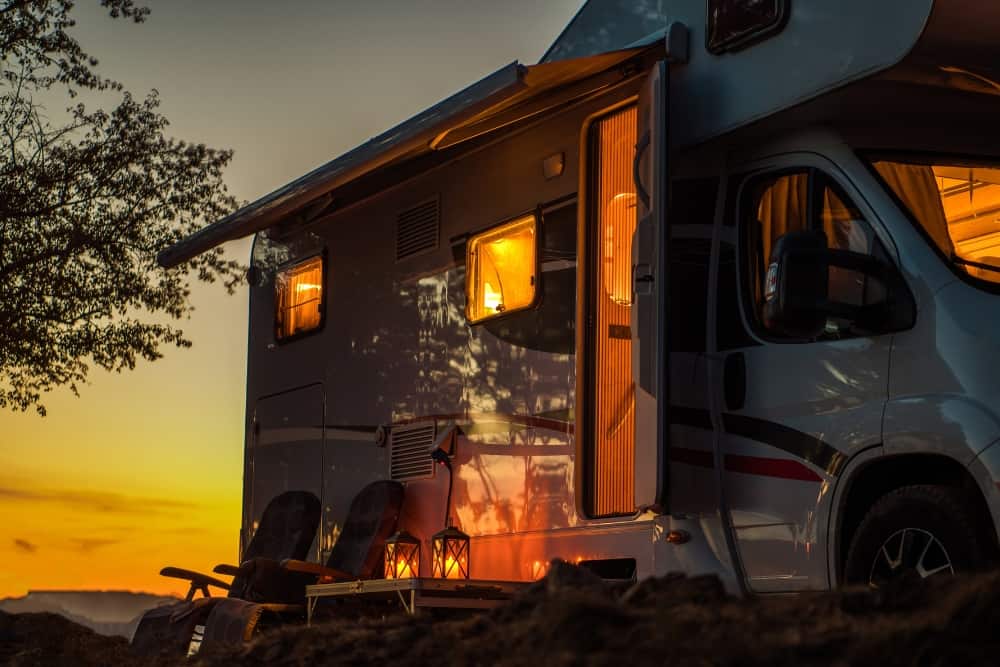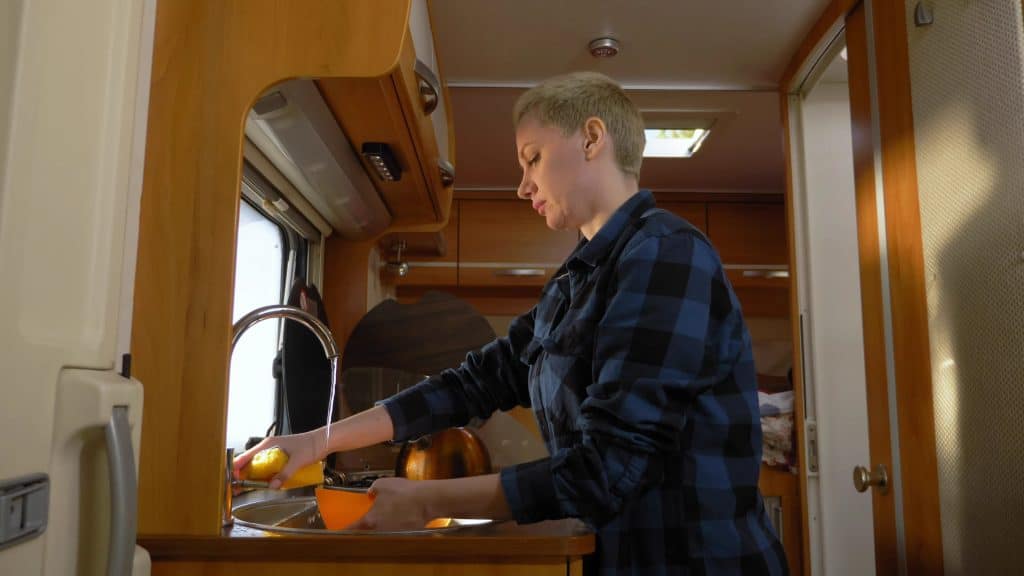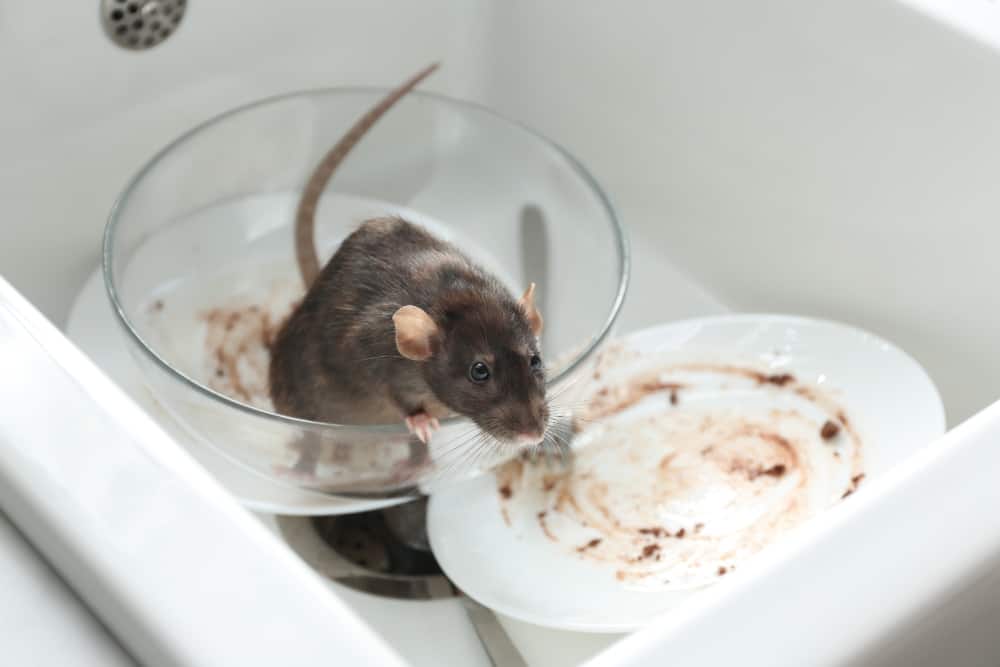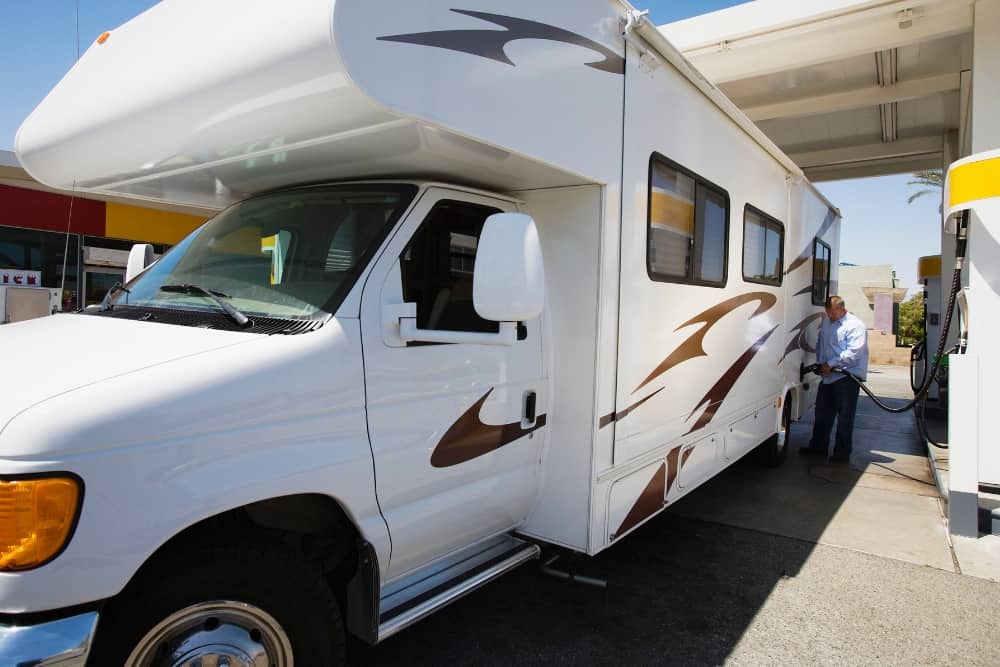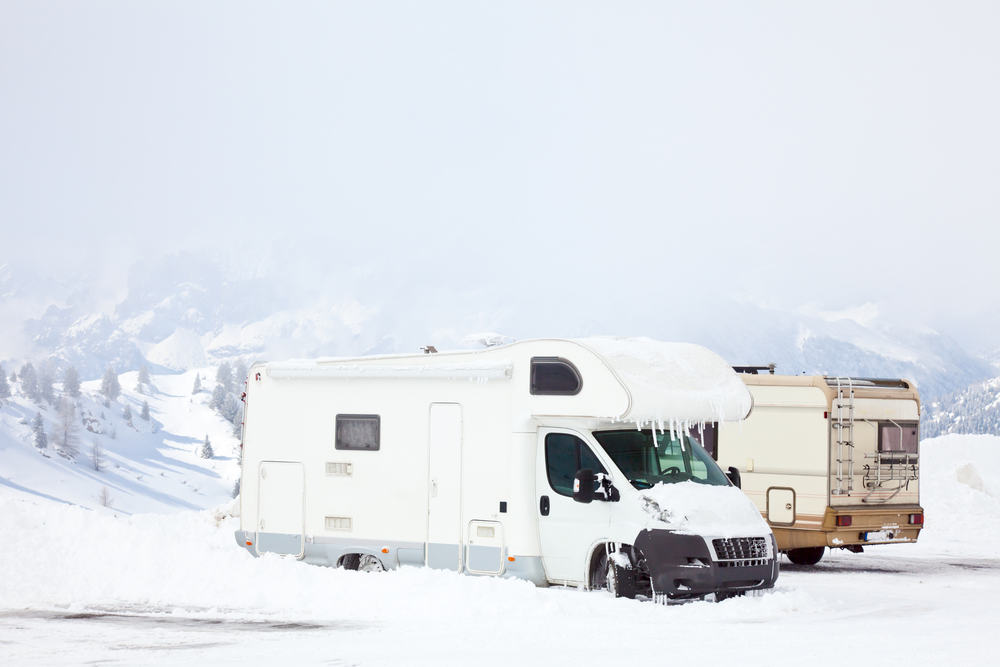Forgetting to winterize your RV ahead of cold weather is one of the common mistakes newbie RV owners make. Skipping winterization can have costly consequences for your camper. In this post, we will discuss the dangers of not winterizing your camper. We will also discuss how to prepare your rig for winter weather if you live in it full-time or engage in winter camping.
First, What Does It Mean To Winterize an RV?
Winterizing an RV involves the steps RV owners take to protect a camper from the harsh weather that occurs during the cold months of the year. It mainly revolves around protecting your RV’s plumbing system from potential damage from freezing temperatures. Start by draining all water from the water lines, holding tanks, toilet, hot water heater, and water pump. Then, add RV-safe antifreeze liquid to the most vulnerable areas.
Winterizing also involves protecting the exterior from the elements, cleaning the inside, and sealing gaps that can cause leaks or allow pests to access the interior. These safety procedures are done on all types of RVs, whether you own a campervan, Class A, travel trailer, fifth wheel, or pop-up camper. If temperatures in your area dip below 32 degrees Fahrenheit at any point during the winter, it is best to winterize your rig.
What Happens When You Don’t Winterize Your Camper?

So many things that can go wrong when you neglect your camper during the cold winter months. Here are the dangers of forgetting to winterize your RV:
Pipes May Crack
Damaged pipes are the biggest immediate risk of forgetting to winterize your camper. If you don’t drain your pipes, the water inside will freeze, expand, and create a strain. If temperatures are very low, the pipes, connectors, and valves may crack or even burst, causing extensive damage to your plumbing system.
The resulting leaks will cause water damage to other parts of your RV. Finding and repairing cracked pipes can be complicated and expensive, as the lines are usually well concealed. You’ll have to work with an experienced RV technician to fix the problem. Avoid this by emptying the lines before the chilly season sets in. Open all faucets, showers, and low-point drains for at least 15 minutes.
Holding Tanks May Freeze and Crack
Another serious problem you could be looking at is a frozen freshwater tank, gray water tank, and black tank. Any liquid inside these spaces may freeze and cause the tanks to crack, causing expensive damage. Just before the colder months arrive, drive to the nearest dump station and empty your gray and black water tank.
Flush and rinse both tanks using a cleaning wand or in-built flush to ensure there is no residue left. When you’re back home, empty the clean water tank by opening the drain plug, usually located on the underside of the camper. Check your owner’s manual for the plumbing spec sheet if you are unsure.
Appliance Damage
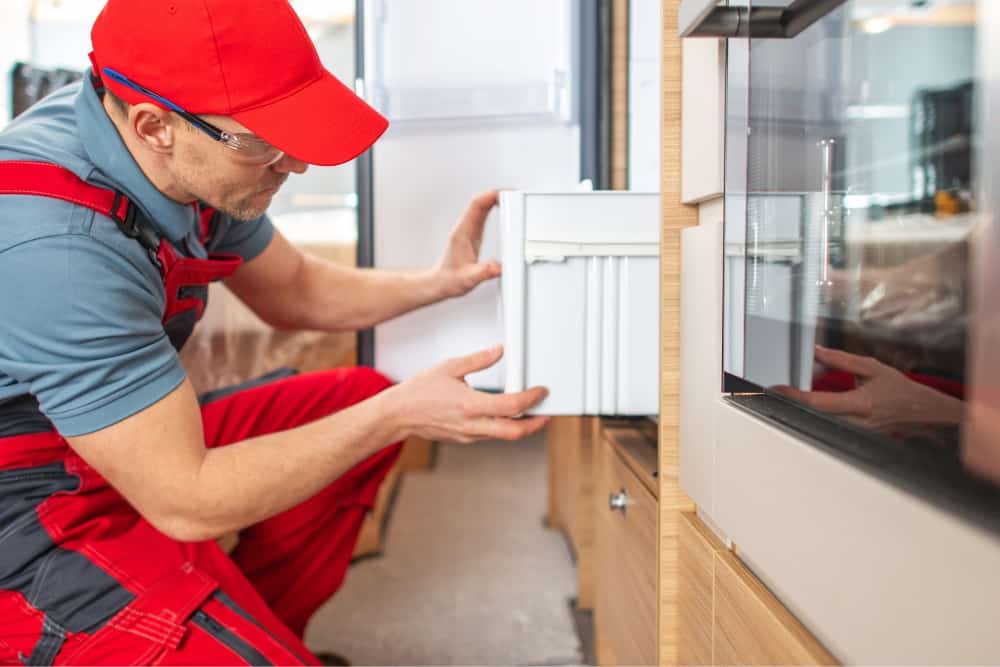 Besides broken pipes and tanks, freezing temperatures can damage any place water is contained. That includes faucets, p-traps, toilet valves, the hot water tank, and water pump. You need to drain all water from these systems to prevent cracks.
Besides broken pipes and tanks, freezing temperatures can damage any place water is contained. That includes faucets, p-traps, toilet valves, the hot water tank, and water pump. You need to drain all water from these systems to prevent cracks.
Also, icemakers, washing machines, and dishwashers have to be emptied of water. Remember that water in some areas, like the p-traps and toilet valve, won’t properly drain even when you open the faucets or flush the toilet. That’s why it’s important to add RV antifreeze, which is not the same thing as the gallons of antifreeze sold for vehicles each year. You can also blow compressed air through the city water inlet to ensure the lines are totally free of water.
Dead Batteries
If you forget to winterize your RV, your lead-acid deep-cycle batteries could suffer irreversible damage. These types of batteries need regular maintenance, and neglecting them reduces their capacity and lifespan.
Protect your chassis and house batteries by removing them from your motorhome or trailer and placing them indoors in a warm, dry area. Consider adding insulation around the batteries to prevent them from freezing. More importantly, connect them to a trickle charger and regularly check and top off the water levels.
Tires Deterioration
If your rig is stored outside and exposed to wintry conditions, your tires could degrade. The rubber may become brittle and harder and may eventually crack, leading to premature replacement. Your tires may also develop flat spots, which may cause vibration or a loss of steering capacity, compromising your safety on the road.
To prevent such issues, thoroughly wash and inflate your tires to the maximum recommended pressure. Next, raise the tires into jacks to get the weight off them, which averts flat spots. Finally, get tire covers to shield your wheels from the impacts of the great outdoors, such as rainwater, snow, excessive sunlight, and even wind.
Mold and Mildew Issues

If you don’t take measures to winterize your RV, mold and mildew may invade the camper. Mold thrives in moist environments, making winter a perfect time for it to spread. It can feed on anything organic inside your RV, from wooden furniture, upholstery, pop-up trailer canvas to carpets. Breathing in its spores is also a health hazard.
To prevent mold or mildew damage, wipe and mop all surfaces, then dry all areas thoroughly. Ensure there is no standing water. Consider applying an anti-mold spray to your bathroom and kitchen sinks and counters. Other solutions include running a dehumidifier once a week or leaving a moisture-absorbing material inside the RV, such as a moisture absorber. If you decide to use an RV cover, find one that’s breathable and that won’t trap moisture.
Interior Moisture Damage
Mold isn’t the only problem linked to moisture. If you don’t prepare your RV for the winter, excess moisture buildup can cause wood to warp, expand, and lose structural integrity over time. If not addressed, it can damage RV walls, floors, and roofs.
Moisture accumulates inside your rig through condensation, high humidity, and leaking pipes. It can also result from cracks in deteriorating sealant around roof vents, skylights, and windows. Fix any damaged seals and caulk, address leaking plumbing systems, and get a dehumidifier to pull moisture out of the interior air.
Pest Infestation
Another risk of forgetting to winterize your RV is that rodents and mice will turn your RV into a winter getaway. Food is the main reason mice and bugs are attracted to the interior of your camper. They will also use the interior as a shelter since it’s protected from the brutal elements.
Rodents cause the most damage, chewing into or through almost anything. They could shred your sofas, cut wires, and make holes in the wall. To avoid this, remove all food items and plug all small and large gaps around the RV before putting your rig into hibernation until next spring.
Problematic Locks, Hinges, and Slides
Lubricating your RV’s moving parts is an important step before storing your rig for winter. Skipping this part will eventually cause excessive wear, corrosion, reduced performance, premature failure, and irritating noises. The most affected parts are door locks, hinges, latches, slide-outs, awning hardware, drawer glides, and window tracks.
To extend the life of these parts and to keep them working smoothly, use lubricants like dry graphite, silicone spray, and WD40. For exterior parts that may be exposed to outside elements, consider an RV lubricant to help prevent corrosion.
Rust in Fuel Tank

If you’re a motorhome owner, your fuel tank could be exposed to rust if it remains idle for months. Before putting your RV for the long winter sleep, fill the fuel tank to the brim. This eliminates airspace in the tank and prevents condensation.
When moisture collects on the side of tank, it may cause rust and damage the tank permanently. Also, fuel goes stale and gels if you don’t start your RV’s engine for a long period. So, it’s a good idea to add an appropriate fuel stabilizer to the fuel tank. Start the RV and run it for 10 minutes to mix it in.
Structural Damage
Improper RV protection during the winter months can lead to damage caused by the elements or surroundings. For instance, RV roofs aren’t meant to withstand the weight of heavy snow. If snow is allowed to pile up, the roof and supporting walls may cave in and cause expensive damage. The snow could also melt and send the water runoff inside cracks and crevices on the roof.
And if the melt refreezes, the cracks will expand. The runoff may also reach the interior, causing water damage. Further, if your RV isn’t protected by a shed or shelter, nearby branches may break and fall on it due to the added weight of snow or ice. Avoid this by parking your RV under covered storage. Don’t forget to add a cover to protect the RV’s paint and decals against UV radiation and to prevent dents in your walls, AC vents, and windows.
RV May Get Trapped in Snow, Ice, or Mud

One more reason why you can’t afford to neglect your camper during the winter is that it can get stuck around heavy snow and ice build-up. This means you won’t be able to get it out of that spot. So it’s impossible to use it in the winter or early spring.
Heavier rigs may also sink into soft ground or mud if they remain stationary for too long. That creates problems when you want to prepare for a trip. You may be forced to remove it with a powerful tow truck. Prevent this by storing your camper on a hard surface, such as a concrete pad.
FAQS
Here are some frequently asked questions regarding RV winterization.
Do I Need to Winterize My Camper If It Never Freezes Where I Live?
Fully winterize your RV if temperatures in your area venture below 32 degrees for more than 24 hours. People who live in warmer climates might not need to add antifreeze to their water lines if temperatures in your region never go beyond freezing.
However, you’ll still need to perform other winterization tasks like draining the lines and tanks, cleaning the rig, closing gaps that might allow mice or other pests to enter, and covering the tires. Other protective measures include lubricating moving parts, addressing moisture issues, storing the RV in a secure shelter, and covering it.
Do I Need to Winterize My RV if I Live In It?
If you live in your camper full time, you don’t need to completely winterize your RV. But there are a few steps you can take to keep the various systems healthy and functional. Here are a few tips:
Enclose the bottom of the outside of your RV with RV skirting to prevent cold air and wind from reaching the underbelly. This also prevents warm air generated inside the RV from escaping.
Buy tank heaters and place them on the gray, black, and fresh water tanks.
Install a heat bulb in the crawl space near your vulnerable tanks and water lines.
Wrap your exposed water pipes with heat tape or foam insulation.
If you have no power hookup, run the propane furnace frequently.
If you’re on shore power, invest in a portable electric space heater or permanent electric fireplace to keep the inside warm.
Inspect the insulation on your windows and doors and seal drafty areas.
Insulate the floors by laying a carpet, rug, or foam tiles.
Ventilate your rig to keep condensation from forming.
Use Technology to Keep Up With RV Winter Maintenance
If you don’t want to forget to winterize your RV, adopt an RV maintenance platform that alerts you what task is coming up. A tool like RV LIFE Maintenance allows you to create a winterizing schedule and upload it. It then sends email reminders to keep you up-to-date on what needs to be done. Harness the power of technology to keep your rig running well for years to come.
More From RV Top Tips
RV Queen Mattress vs. Regular Mattress: What’s the Difference?

Cynthia Measom
Cynthia Measom is the founder and main content creator of RV Top Tips. Not just a writer, she’s a dedicated RV owner and enthusiast, alongside her husband, Joe, who is an experienced RV tech. With their joint knowledge, the two are up on the latest trends and technologies in the RV industry, as well as practical camping and lifestyle tips.
The couple own a 2020 Coachmen Chaparral fifth-wheel that they absolutely love. Their secret to being so satisfied? They purchased the model after a solid year of researching different fifth-wheel campers in person and online to find the perfect fit for their family of three.
Cynthia Measom is the founder and main content creator of RV Top Tips. Not just a writer, she’s a dedicated RV owner and enthusiast, alongside her husband, Joe, who is an experienced RV tech. With their joint knowledge, the two are up on the latest trends and technologies in the RV industry, as well as practical camping and lifestyle tips.
The couple own a 2020 Coachmen Chaparral fifth-wheel that they absolutely love. Their secret to being so satisfied? They purchased the model after a solid year of researching different fifth-wheel campers in person and online to find the perfect fit for their family of three.
- Cynthia Measomhttps://rvtoptips.com/author/admin_rvtoptips/July 28, 2025
- Cynthia Measomhttps://rvtoptips.com/author/admin_rvtoptips/July 25, 2025
- Cynthia Measomhttps://rvtoptips.com/author/admin_rvtoptips/July 23, 2025
- Cynthia Measomhttps://rvtoptips.com/author/admin_rvtoptips/April 23, 2025

